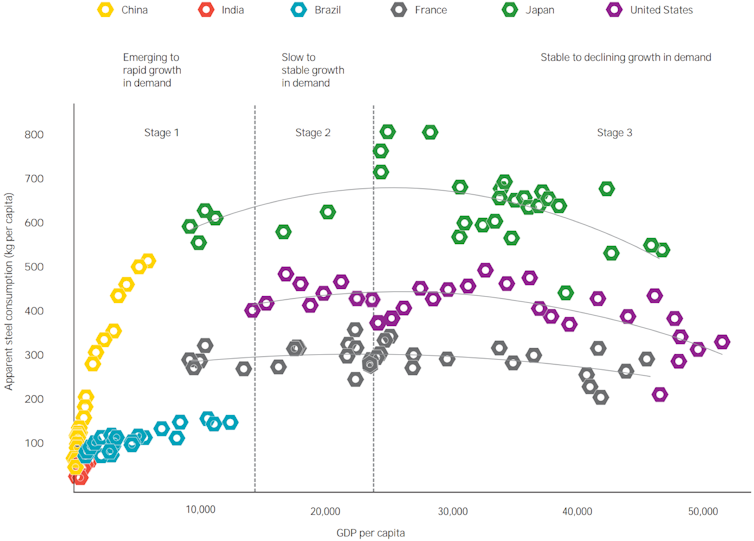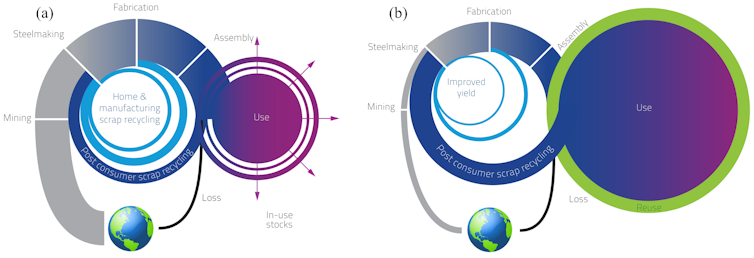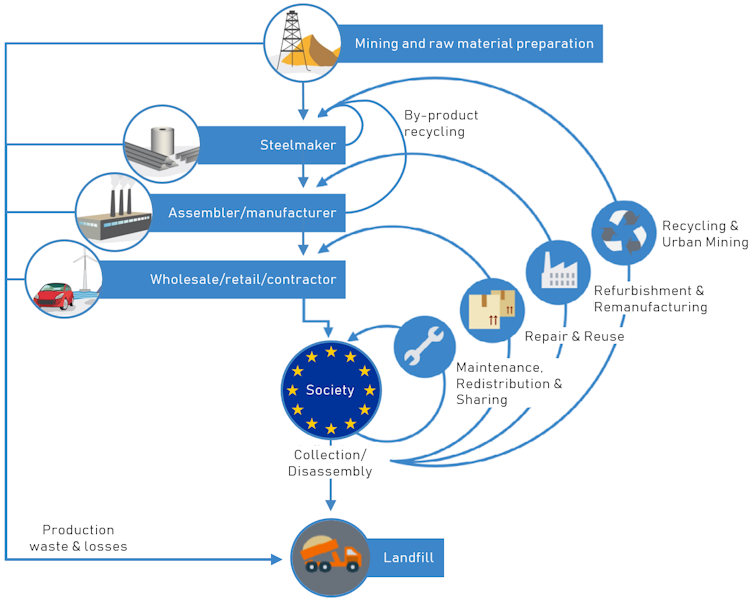Recycling, remanufacturing and refurbishing are indisputably important tools for reducing our consumption of natural resources. These activities contribute to what scientists call circularity: making sure we use materials for as long as possible, over and over, so that we exploit nature less and less.
Doing so requires creating what are called “secondary markets”, where used materials are gathered up, reworked and injected back into the economy. While this is an essential part of creating circularity, there can sometimes be unintended and negative consequences. A striking example is the secondary metals market: it has been a success), creating new jobs and business opportunities), but the environmentally friendly goal that it once had is no longer a priority.
In Europe, we recycle more than 70% of used steel on average, and just over 30% of all recycled or remanufactured steel is produced in furnaces that use electricity rather than burning coal. Not bad, but no longer enough when considering the increasing steel demand from developing nations, which are growing rapidly.
Examples of growing and mature apparent steel consumption levels as function of GDP. Ernst&Young, Author provided
Although iron itself is an element that is infinitely recyclable, steel is a combination of iron and other elements such as carbon, nickel, chromium or manganese. Different compositions alter the mechanical properties of steel for use in different applications, but that complicates recycling. So even if iron itself does not necessarily downcycle, steel alloys can: after multiple recycling and remanufacturing cycles, unless the proportions of the elements that make up an alloy are adjusted, it might no longer have the same characteristics as the original steel or, more likely, no longer be as useful or valuable when compared to newer alloys.
Recycling and remanufacturing steel do help reduce the need for natural resources). Unfortunately, though, much of the metal recovered from our cars, phones and refrigerators, as well as from tools and machinery, is more likely to end up as steel scrap available for sale than actually going back to their own supply chains. Such scrap can end up being bought for recycling or remanufacturing by either completely different steelmakers from those who originally produced it or by those outside of European borders.
How the circular becomes linear
Because an increasing amount of steel scrap is leaving Europe, its composition receives less attention – the goal is to supply developing nations as quickly as possible with alloys that are less complex and more bulk-oriented. Not all steel needs to go back to its origin for circularity to take place and be useful, but the less attention we give to how steel circulates, the less environmental benefits we accrue from the secondary metals market.
Together, these developments have effectively created a circularity paradox: the solution we thought would increase circularity has became another linear operation of its own. By using linear solutions to approach circular goals, we are not actually changing the mindset of standard industrial operations. Instead, we are just pushing it further down the line. Consequently, the benefits of using recycling, refurbishing and remanufacturing to close loops in supply chains and reduce the need for mining iron ore are no longer as evident as we had hoped. Worse, all the effort put into making all those complex and high-added-value steel alloys ends up either downcycling or leaving Europe altogether.
But what if we kept better track of steel? During the development of the AdaptEcon2 project “Sustainable Resource Management in European Steel Supply Chains”, we found out that the more integrated supply chains are, the easier it is to track the lifecycle of steel alloys and the elements that go into them. Higher levels of integration make it easier to bring steel back via reverse logistics without losing too much value. The more you do this, the less iron ore you need to mine and melt, and the longer the reserves of high-grade iron ore – which needs less energy to transform into steel – will last. And integrating supply chains does not necessarily mean having the different steps all within the same company.
Using steel steel more intelligently
What happens on the manufacturing and consumption ends is also important. During our study, we were also able to reinforce the notion that steel’s share of emissions during its use phase can be reduced by:
-
Focusing on public transportation rather than using the same amount of steel to produce cars.
-
Using steel in solar-energy infrastructure rather than the same amount as part of a hydropower plants, for example.
-
Manufacturing appliances with energy-efficient steel, which use the same amount of iron but different alloying elements, so less electricity is required to operate them.
What if we could stimulate the use of more renewable sources of electricity to help supply those steelmakers using electric furnaces? Although steelmaking is highly energy intensive, the more renewables are a part of supplying that energy, the lower will be the emissions footprint of both the steel being produced as well as of the renewable energy hardware that contains this steel. While a complete shift to renewables is unlikely for this sector, this would create a reinforcing feedback loop that favors both sectors in the long-term.
European steel today (a) and vision for 2050 (b). EUROFER, Author provided
By far the most interesting result of the project was that added value, circularity and service life are much more closely related than we had expected. In other words, the more a steelmaker adds value to a steel alloy, the better it is for the steelmaker not only to make sure it comes back home at the end of its life, but also that this steel alloy can remain circulating over and over for as long as possible. And the key to making it happen resides in resource ownership.
On the good side, Europe has been putting a lot of effort on promoting circularity, especially in the end-of-life phase of products). And finding a balance between bulk and speciality alloys is something that the steel industry already does very well for their own competitive interests. But when it comes to service life of manufactured goods, we still live in the age of programmed and planned obsolescence. And although end-of-life circularity helps mitigate some of the effects of these intentionally shortened service lives, the core issue remains unanswered: how to make materials circulate for longer?
Thinking strategically
What is required is to show steelmakers that there’s a lot of value that they can retain by focusing on resource ownership. We need to help ensure that steel comes back to the supply chain in which it was produced, so that we can accrue value from the same steel product, over and over.
The steel supply chain as seen by the Circular Economy Framework. Ellen McArthur Foundation, Author provided
Thankfully, the technologies and applications of Industry 4.0 are already out there. Tools such as RFIDs, GPS tagging, QR codes, the Internet of Things (IoT) and machine learning are becoming commonplace in manufacturing and assembly. There is also a lot that we can learn from the service sector when it comes to business models that benefit from different ownership modes. So why not give more attention to the extraction and transformation steps using these tools? To address the service life and resource ownership issue that could help us improve circularity, we need to take two important steps:
-
Develop markers capable of withstanding the whole life cycle of a steel product, repeatedly.
-
Create a business model capable of keeping track and managing the comings and goings of these materials and goods, borrowing ideas from servitisation.
The key is to show stakeholders that it is worthwhile to develop alloys that last longer because no matter how far it travels, it will always come home. Home where their composition is known and where the machinery is suited to adjust its alloying characteristics so it remains useful and competitive for longer. Home, where it can be fed back into the supply chain that is already prepared to receive it and work with it once again. Home where the costs are lower.
Despite European efforts in end-of-life circularity, we believe more needs to be done upstream, right where most of the environmental impacts are born. Bringing the responsibility of circularity back to extraction and transformation might not only be cost-effective, but actually make materials circularity-ready from the very moment they leave nature, combating the paradox that brought us back to the linear mindset.



 Airline Loyalty Programs Face New Uncertainty as Visa–Mastercard Fee Settlement Evolves
Airline Loyalty Programs Face New Uncertainty as Visa–Mastercard Fee Settlement Evolves  Silver Spikes to $62.89 on Fed Cut – But Weekly Bearish Divergence Flashes Caution: Don’t Chase, Wait for the Dip
Silver Spikes to $62.89 on Fed Cut – But Weekly Bearish Divergence Flashes Caution: Don’t Chase, Wait for the Dip  Asia’s IPO Market Set for Strong Growth as China and India Drive Investor Diversification
Asia’s IPO Market Set for Strong Growth as China and India Drive Investor Diversification  Fed Near Neutral Signals Caution Ahead, Shifting Focus to Fixed Income in 2026
Fed Near Neutral Signals Caution Ahead, Shifting Focus to Fixed Income in 2026  Evercore Reaffirms Alphabet’s Search Dominance as AI Competition Intensifies
Evercore Reaffirms Alphabet’s Search Dominance as AI Competition Intensifies  Holiday Economic Questions: What Bank of America Says You Should Expect
Holiday Economic Questions: What Bank of America Says You Should Expect 


































